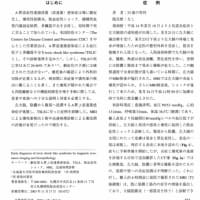Liberal or restrictive transfusion after cardiac surgery.
Murphy GJ, Pike K, Rogers CA, Wordsworth S, Stokes EA, Angelini GD, Reeves BC; TITRe2 Investigators. Collaborators (79)
N Engl J Med. 2015 Mar 12;372(11):997-1008. doi: 10.1056/NEJMoa1403612.
<松田直之 コメント>
日本では,白血球除去製剤として赤血球製剤(MAP製剤)が使用できます。
特に,心機能低下症例では,酸素需給の適正化のために,Hb 10g/dLレベルのHb濃度を維持することが大切と考えます。
BACKGROUND:
Whether a restrictive threshold for hemoglobin level in red-cell transfusions, as compared with a liberal threshold, reduces postoperative morbidity and health care costs after cardiac surgery is uncertain.
METHODS:
We conducted a multicenter, parallel-group trial in which patients older than 16 years of age who were undergoing nonemergency cardiac surgery were recruited from 17 centers in the United Kingdom. Patients with a postoperative hemoglobin level of less than 9 g per deciliter were randomly assigned to a restrictive transfusion threshold (hemoglobin level <7.5 g per deciliter) or a liberal transfusion threshold (hemoglobin level <9 g per deciliter). The primary outcome was a serious infection (sepsis or wound infection) or an ischemic event (permanent stroke [confirmation on brain imaging and deficit in motor, sensory, or coordination functions], myocardial infarction, infarction of the gut, or acute kidney injury) within 3 months after randomization. Health care costs, excluding the index surgery, were estimated from the day of surgery to 3 months after surgery.
<font size="3">RESULTS:
A total of 2007 patients underwent randomization; 4 participants withdrew, leaving 1000 in the restrictive-threshold group and 1003 in the liberal-threshold group. Transfusion rates after randomization were 53.4% and 92.2% in the two groups, respectively. The primary outcome occurred in 35.1% of the patients in the restrictive-threshold group and 33.0% of the patients in the liberal-threshold group (odds ratio, 1.11; 95% confidence interval [CI], 0.91 to 1.34; P=0.30); there was no indication of heterogeneity according to subgroup. There were more deaths in the restrictive-threshold group than in the liberal-threshold group (4.2% vs. 2.6%; hazard ratio, 1.64; 95% CI, 1.00 to 2.67; P=0.045). Serious postoperative complications, excluding primary-outcome events, occurred in 35.7% of participants in the restrictive-threshold group and 34.2% of participants in the liberal-threshold group. Total costs did not differ significantly between the groups.
CONCLUSIONS:
A restrictive transfusion threshold after cardiac surgery was not superior to a liberal threshold with respect to morbidity or health care costs. (Funded by the National Institute for Health Research Health Technology Assessment program; Current Controlled Trials number, ISRCTN70923932.).


参考資料
Transfusion Indication Threshold Reduction (TITRe2) randomized controlled trial in cardiac surgery: statistical analysis plan.
Pike K, Nash RL, Murphy GJ, Reeves BC, Rogers CA.
Trials. 2015 Dec;16(1):564. doi: 10.1
Restrictive versus liberal transfusion strategy for red blood cell transfusion: systematic review of randomised trials with meta-analysis and trial sequential analysis.
Holst LB, Petersen MW, Haase N, Perner A, Wetterslev J.
BMJ. 2015 Mar 24;350:h1354. doi: 10.1136/bmj.h1354.
Murphy GJ, Pike K, Rogers CA, Wordsworth S, Stokes EA, Angelini GD, Reeves BC; TITRe2 Investigators. Collaborators (79)
N Engl J Med. 2015 Mar 12;372(11):997-1008. doi: 10.1056/NEJMoa1403612.
<松田直之 コメント>
日本では,白血球除去製剤として赤血球製剤(MAP製剤)が使用できます。
特に,心機能低下症例では,酸素需給の適正化のために,Hb 10g/dLレベルのHb濃度を維持することが大切と考えます。
BACKGROUND:
Whether a restrictive threshold for hemoglobin level in red-cell transfusions, as compared with a liberal threshold, reduces postoperative morbidity and health care costs after cardiac surgery is uncertain.
METHODS:
We conducted a multicenter, parallel-group trial in which patients older than 16 years of age who were undergoing nonemergency cardiac surgery were recruited from 17 centers in the United Kingdom. Patients with a postoperative hemoglobin level of less than 9 g per deciliter were randomly assigned to a restrictive transfusion threshold (hemoglobin level <7.5 g per deciliter) or a liberal transfusion threshold (hemoglobin level <9 g per deciliter). The primary outcome was a serious infection (sepsis or wound infection) or an ischemic event (permanent stroke [confirmation on brain imaging and deficit in motor, sensory, or coordination functions], myocardial infarction, infarction of the gut, or acute kidney injury) within 3 months after randomization. Health care costs, excluding the index surgery, were estimated from the day of surgery to 3 months after surgery.
<font size="3">RESULTS:
A total of 2007 patients underwent randomization; 4 participants withdrew, leaving 1000 in the restrictive-threshold group and 1003 in the liberal-threshold group. Transfusion rates after randomization were 53.4% and 92.2% in the two groups, respectively. The primary outcome occurred in 35.1% of the patients in the restrictive-threshold group and 33.0% of the patients in the liberal-threshold group (odds ratio, 1.11; 95% confidence interval [CI], 0.91 to 1.34; P=0.30); there was no indication of heterogeneity according to subgroup. There were more deaths in the restrictive-threshold group than in the liberal-threshold group (4.2% vs. 2.6%; hazard ratio, 1.64; 95% CI, 1.00 to 2.67; P=0.045). Serious postoperative complications, excluding primary-outcome events, occurred in 35.7% of participants in the restrictive-threshold group and 34.2% of participants in the liberal-threshold group. Total costs did not differ significantly between the groups.
CONCLUSIONS:
A restrictive transfusion threshold after cardiac surgery was not superior to a liberal threshold with respect to morbidity or health care costs. (Funded by the National Institute for Health Research Health Technology Assessment program; Current Controlled Trials number, ISRCTN70923932.).


参考資料
Transfusion Indication Threshold Reduction (TITRe2) randomized controlled trial in cardiac surgery: statistical analysis plan.
Pike K, Nash RL, Murphy GJ, Reeves BC, Rogers CA.
Trials. 2015 Dec;16(1):564. doi: 10.1
Restrictive versus liberal transfusion strategy for red blood cell transfusion: systematic review of randomised trials with meta-analysis and trial sequential analysis.
Holst LB, Petersen MW, Haase N, Perner A, Wetterslev J.
BMJ. 2015 Mar 24;350:h1354. doi: 10.1136/bmj.h1354.



























